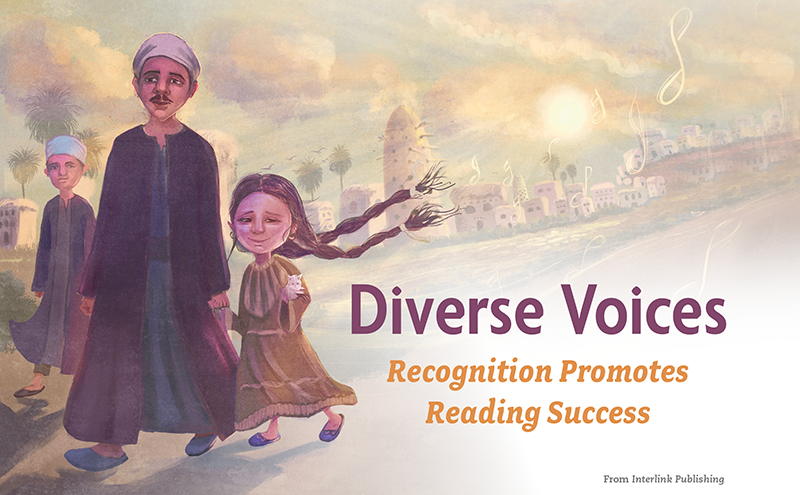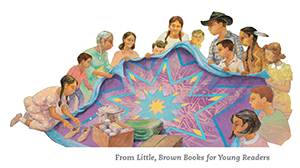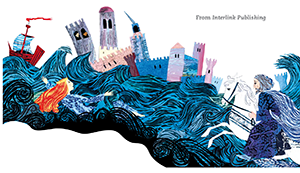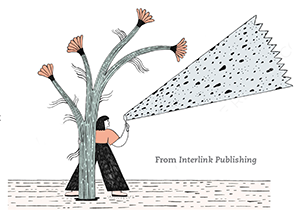Diverse Voices: Recognition Equals Reading Success
As teachers and school librarians work to add more diverse voices to their libraries’ collections, we continue learning more about the impact of these efforts on literacy. According to First Book Research & Insights, “a majority of students chose to read diverse books that serve as mirrors, where they can see themselves.”


As teachers and school librarians work to add more diverse voices to their libraries’ collections, we continue learning more about the impact of these efforts on literacy. According to First Book Research & Insights, “a majority of students chose to read diverse books that serve as mirrors, where they can see themselves.” In fact, the latest data from the report found that after more diverse books were added to classroom libraries, students’ reading scores increased—most dramatically among the lowest-scoring and youngest students. And 70 percent of students chose books with characters whose identities mirrored their own.
The result? Students spent an average of four more hours per week reading.
Still, nearly half of the 4,240 book titles targeted for censorship in 2023 represented the voices and experiences of LGBTQIA+ and BIPOC individuals, according to the ALA’s latest data. “We’re obviously well aware of what’s going on with book banning and the controversies,” says Carol Hinz, associate publisher of Millbrook Press & Carolrhoda Picture Books, imprints of Lerner Books. “And our commitment to publishing diverse voices is unshaken. We are continuing to forge ahead with the books that we believe are essential for young readers of all backgrounds.”
Victoria Stapleton, executive director of school and library marketing at Little, Brown Books for Young Readers, takes umbrage with arguments claiming that certain books aren’t relevant to all kids. “Many common experiences are conveyed in a culturally specific way that children can access,” she says. While one child’s way into a book might be a shared identity, another’s might be a shared experience—a bad day at school, loneliness, or feeling misunderstood.
Here, five publishers preview new titles that will help children see themselves in books and in others.
Little, Brown Books for Young Readers
Little, Brown Books for Young Readers, an imprint of Hachette Book Group, prides itself on offering children a menu of diverse reading choices. “We’ve always had titles from a multiplicity of perspectives,” says Victoria Stapleton, executive director of school and library marketing. “We want to provide a varied book diet, a banquet of reading choices for young readers.”
One recent addition to Little, Brown’s menu, Wings of an Eagle by Billy Mills and Donna Janell Bowman, illustrated by S.D. Nelson, ISBN 9780316373487, came out in July 2024 just before the Summer Olympics. This picture-book biography for ages 5 and up tells the story of 1964 Olympic gold medalist runner Billy Mills’ challenging childhood in South Dakota and how running helped him cope. “S.D. has painted the illustrations on Masonite and built in a lot of texture about this boy’s emotions, his heritage, his traditions, and his community—a specific Oglala Sioux community,” Stapleton says.
Indigenous Ingenuity: A Celebration of Traditional North American Knowledge by Deidre Havrelock and Edward Kay, September 2024, ISBN 9780316413435, is another illustrated nonfiction title. For readers ages 8–12, this engaging book traces numerous everyday things and practices of modern life—corn, chocolate, boats that float, disinfectant, forest fire management, and brain surgery, to name just a few—back to their origins in Indigenous cultures. “For a kid who is very fact-oriented, this is an excellent book to get [him or her] thinking about where everything came from,” Stapleton says.
Raven’s Ribbons by Tasha Spillett, illustrated by Daniel Ramirez, January 2025, ISBN 9780316422161, introduces the concept of intersectionality to children as young as four through the story of a child called Raven.  Raven loves Indigenous round dances and the ribbon-trimmed skirts traditionally worn to perform them. He wishes he could wear one, but boys don’t wear ribbon skirts. His grandmother helps Raven understand the complexities of gender identity exploration and challenging cultural norms. “Who gets to wear a ribbon skirt is a very specific cultural expectation,” Stapleton says. “But how a child navigates their wish to explore their own agency—that's a place where any child can access this story, find empathy, meaning, and value within it.”
Raven loves Indigenous round dances and the ribbon-trimmed skirts traditionally worn to perform them. He wishes he could wear one, but boys don’t wear ribbon skirts. His grandmother helps Raven understand the complexities of gender identity exploration and challenging cultural norms. “Who gets to wear a ribbon skirt is a very specific cultural expectation,” Stapleton says. “But how a child navigates their wish to explore their own agency—that's a place where any child can access this story, find empathy, meaning, and value within it.”
Interlink Publishing
The only Palestinian-owned publisher in the United States, Interlink Publishing was founded to bring Middle Eastern voices to American readers. “When my parents arrived here in the 1970s, they were really disappointed in the representation of Middle Easterners in western media,” says Marketing and Publicity Manager Hannah Moushabeck, who, along with her siblings, took ownership of the family-owned press in July. “We’re the number one publisher of Arabic fiction and translation.” During its 37 years, Interlink has expanded to amplify voices from all parts of the world.
 Journalist Ellen Ryan reimagines Irish mythology for children ages 9–12 in Girls Who Slay Monsters: Daring Tales of Ireland's Forgotten Goddesses, illustrated by Shona Shirley MacDonald, September 2024, ISBN 9781623716738. Giant fashionista Bé Binn, who perseveres despite bullying, Badb Catcha, also known as “The Harbinger of Doom,” gender-fluid spy from Dublin Bé Mannair, and Ireland’s first farmer Tailtiu, all appear among 20 other mythical Irish goddesses.
Journalist Ellen Ryan reimagines Irish mythology for children ages 9–12 in Girls Who Slay Monsters: Daring Tales of Ireland's Forgotten Goddesses, illustrated by Shona Shirley MacDonald, September 2024, ISBN 9781623716738. Giant fashionista Bé Binn, who perseveres despite bullying, Badb Catcha, also known as “The Harbinger of Doom,” gender-fluid spy from Dublin Bé Mannair, and Ireland’s first farmer Tailtiu, all appear among 20 other mythical Irish goddesses.
The Spoon by Sandra Siemens, illustrated by Bea Lozano, October 2024, ISBN 9781623716509, is a picture book for ages 5–7. A little girl tries to use a particular spoon several different ways and is told over and over “not that spoon.” “That spoon isn’t for soup,” her mother says. Nor is it for digging holes or playing music. Eventually her parents explain that the spoon is the only piece of silverware that her great-grandmother was able to bring with her when she fled war in her homeland and immigrated.
 A Symphony of Stories: Musical Myths and Tuneful Tales by James Mayhew, October 2024, ISBN 9781623716493, is an introduction to classical music for children ages 7 and up. The collection features six stories inspired by orchestral pieces from world-famous composers, accompanied by colorful illustrations. For example, in the story of Antonio Vivaldi’s The Four Seasons, Antonio wants to write a violin concerto but experiences writer’s block. While he’s struggling to compose, finds inspiration in the characteristics of each season as he experiences them in the country.
A Symphony of Stories: Musical Myths and Tuneful Tales by James Mayhew, October 2024, ISBN 9781623716493, is an introduction to classical music for children ages 7 and up. The collection features six stories inspired by orchestral pieces from world-famous composers, accompanied by colorful illustrations. For example, in the story of Antonio Vivaldi’s The Four Seasons, Antonio wants to write a violin concerto but experiences writer’s block. While he’s struggling to compose, finds inspiration in the characteristics of each season as he experiences them in the country.
In November, Interlink will publish the first-ever graphic novel edition of Lebanese American Kahlil Gibran’s 1923 prose-poetry classic The Prophet, illustrated by Zeina Abirached, ISBN 9781623716455. “It is one of the highest selling books of our time after the Quran and the Bible,” Moushabeck says. “A lot of high schools are assigning The Prophet, and this is such an accessible way to read it and to get a real sense of what the book is about. It will be perfect for anyone intimidated by classics or more text-heavy books.” Abirached, a Lebanese graphic novelist, has a distinct style that Moushabeck says represents the Middle East perfectly.
Syrian American journalist Rhonda Roumani has written about Islam, the Arab world, and Muslim American issues for more than two decades. Her latest work, Umm Kulthum: Star of the East, illustrated by Ahmed Abdelmohsen, November 2024, ISBN 9781623716608, is a picture book for children ages 7–12. Expressive color illustrations show the story of the life and career of the iconic Egyptian singer, songwriter, and film actress Umm Kulthum.
Live Like a Goddess: Life Lessons from Legends and Lore by Jean Menzies, illustrated by Taylor Dolan, November 2024, ISBN 9781623716578, is another collection of myths and legends. For readers ages 12 and up, each of these 21 ancient stories of goddesses from around the world—from Hawaiian Pele to Welsh Rhiannon to Chinese Nuwa—offers young people advice for applying their lessons to their modern life.
World Book
Chicago-based World Book published its first encyclopedia in 1917 and continues to update its encyclopedia every year. But the company’s primary focus has shifted to subscription-based educational websites and more than 150 supplemental print titles for schools and libraries each year. Themes of print series run the gamut from space to the human body to nature and animals.
 The latest series, coming in spring 2025, is “Indigenous Peoples of North America,” ISBN 9780716658610, a set of eight volumes for students in grades 4–9. Geographically organized, the volumes include Indigenous Peoples of the Northeast, Southeast, Plains, Southwest, Arctic and Subarctic, Great Basin and Plateau, Pacific Coast, and Hawaii. The series features contributions from numerous scholars in history and Native American studies who have Indigenous ancestry. Donald Fixico (Shawnee, Sac and Fox, Muscogee Creek, and Seminole), professor of history at Arizona State University, is serving as the series advisor and reviewer.
The latest series, coming in spring 2025, is “Indigenous Peoples of North America,” ISBN 9780716658610, a set of eight volumes for students in grades 4–9. Geographically organized, the volumes include Indigenous Peoples of the Northeast, Southeast, Plains, Southwest, Arctic and Subarctic, Great Basin and Plateau, Pacific Coast, and Hawaii. The series features contributions from numerous scholars in history and Native American studies who have Indigenous ancestry. Donald Fixico (Shawnee, Sac and Fox, Muscogee Creek, and Seminole), professor of history at Arizona State University, is serving as the series advisor and reviewer.
The impetus for the series arose from the desperate need for updated, culturally sensitive, and accurate information about Indigenous peoples’ culture and history in U.S. schools and libraries. “The books in libraries were outdated,” says Tom Evans, vice president of editorial. “The terminology was wrong and offensive. There was nothing about Native Americans today—and certainly nothing written by someone who was Indigenous.”
World Book aimed to rectify these issues by starting the books with the introduction of regional Indigenous Nations and exploring their cultures as they exist today, before delving into their history, material culture, traditions, and oral histories. The books also feature essays written by Indigenous people across the country, describing what it’s like to be an Indigenous person in 21st-century America.
Each volume also has a spread devoted to the Native American Graves Repayment Protection and Repatriation Act of 1990 (NAGPRA), describing the removal of materials culturally significant to each area perpetrated by universities and museums and how NAGPRA established a protocol for their return.
“Since about 2004, states have been revising their social studies curriculum standards to include more Indigenous perspectives,” Evans says. “One of our goals is to provide teachers with resource materials that they could use to design their lesson plans and rise to the challenge of these new standards.”
Lerner Publishing Group
“Supporting diverse voices has been part of Lerner culture for a long time,” says Lois Wallentine, school and library marketing director. A browsable Diverse Books collection demonstrates the publisher’s commitment to elevating a range of voices with books that “build understanding with people unlike ourselves, challenge our misconceptions, and broaden our awareness of the world.” And through new partnerships, Lerner has recently translated some titles into Ojibwe and Hmong editions.
“Native Rights,” a new series for grades 3–6, explores the history and cultures of Indigenous peoples and the ways they are reclaiming their rights and heritage. In Native Mascots, Myths, and Misrepresentation, August 2024, ISBN 9798765625552, Ojibwe author Cayla Bellanger DeGroat delves into the battle against Indigenous stereotypes. “The book looks at place names that were drawn from native languages, as well as sports team names, and movie and book representation, helping readers think about it all from the native perspective,” says Amber Ross, director of school/library product planning and development.
Another historical nonfiction title, We Shall Not Be Denied by Cayla Bellanger DeGroat and Cicely Lewis, September 2024, ISBN 9798765611586, for grades 4–8, comes from Lerner’s Read Woke™ Books brand. Just in time for election season, succinct text takes readers through the history of voting rights and suppression in America. A timeline also runs across the bottom of each page. “It highlights the importance of voting as well as modern-day voting rights and issues,” Ross says. “It also offers young readers ways to make a difference, even if they are too young to vote.”
The Doll Test by Carole Boston Weatherford, illustrated by David Elmo Cooper, November 2024, ISBN 9781728477930, for readers ages 7–11, covers the work of two pioneering, Harvard-educated Black psychologists  who researched children’s reactions to segregation in the 1930s. Their experiment used white and black dolls to ask kids questions about race. The results, which demonstrated the deleterious effects of the “separate but equal” doctrine, were used in the landmark Brown v. Board of Education school segregation case. “This book has a lot of adult stuff going on, even though the doll test was done with children,” says Carol Hinz, associate publisher of Millbrook Press and Carolrhoda Picture Books. “So, Weatherford wrote the text from the perspective of the dolls as a way into the story for children.”
who researched children’s reactions to segregation in the 1930s. Their experiment used white and black dolls to ask kids questions about race. The results, which demonstrated the deleterious effects of the “separate but equal” doctrine, were used in the landmark Brown v. Board of Education school segregation case. “This book has a lot of adult stuff going on, even though the doll test was done with children,” says Carol Hinz, associate publisher of Millbrook Press and Carolrhoda Picture Books. “So, Weatherford wrote the text from the perspective of the dolls as a way into the story for children.”
Sweet Cherry Publishing
United Kingdom-based Sweet Cherry was founded in 2011 by Abdul Thadha. “After growing up in an area where few people spoke English, he decided that no other children should experience the same lack of books and reading as he and his friends had,” says Morgan Lloyd, marketing and publicity executive. Sweet Cherry publishes over 100 children’s titles per year in the U.K. and more than 30 in the U.S.
 In Boy Underground by Isabelle Marinov, illustrated by Paula Zorite, September 2024, ISBN 9781802635515, Hugo, a 12-year-old boy with autism, goes into the Paris underground looking for a place where he belongs. In the catacombs, he encounters secret passages, robbers, old friends, and more. For ages 9 and up, “this book is a positive middle-grade adventure in which the main character becomes the hero of his own story,” Lloyd says. “It’s a great representation of one person’s experience with autism. Marinov never tries to preach or claim that Hugo is exactly how everybody with autism is; she’s simply written an authentic story based on her own son.”
In Boy Underground by Isabelle Marinov, illustrated by Paula Zorite, September 2024, ISBN 9781802635515, Hugo, a 12-year-old boy with autism, goes into the Paris underground looking for a place where he belongs. In the catacombs, he encounters secret passages, robbers, old friends, and more. For ages 9 and up, “this book is a positive middle-grade adventure in which the main character becomes the hero of his own story,” Lloyd says. “It’s a great representation of one person’s experience with autism. Marinov never tries to preach or claim that Hugo is exactly how everybody with autism is; she’s simply written an authentic story based on her own son.”
Maggie Sparks and the School of Slime by Steve Smallman, illustrated by Esther Hernando, March 2025, ISBN 9781782267164, is one in a series of five picture books for readers ages 5–7 about a mischievous little witch. Maggie doesn’t want to go to her new school; the students are mean, and she’s sure the teacher is a vampire. But Maggie plans to use her witchy superpowers to get out of this jam. “The book is a really positive representation of interracial family life,” Lloyd says.
One installment in the 10-book “Soccer Rising Stars” series by Harry Meredith, illustrated by Sophie Jones, features Mallory Swanson, March 2025, ISBN 9781802631524. Of biracial heritage, Mallory Swanson is a soccer prodigy, one of the world’s top forwards—and under a lot of pressure. Swanson plays for the Chicago Red Stars and the United States women’s national soccer team (USWNT). For readers ages 7–9, this book tells the story of how she overcame nerves and anxiety to succeed at the international level and become a role model for other young American girls who want to play professional sports.
SPONSORED CONTENT
The job outlook in 2030: Librarians will be in demand
The job outlook in 2030: Librarians will be in demand
ALREADY A SUBSCRIBER? LOG IN
We are currently offering this content for free. Sign up now to activate your personal profile, where you can save articles for future viewing





Add Comment :-
Be the first reader to comment.
Comment Policy:
Comment should not be empty !!!